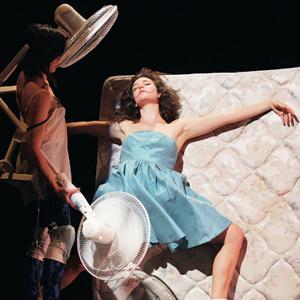
Montrealer Sasha Kleinplatz says Rhubarb-goers will enjoy her performance if they're into "high-femme women beating the shit out of each other."
Though it’s long been a platform for all kinds of experimental performance, this year’s Rhubarb Festival carves out a little extra space for dance. The eclectic program includes all manner of movers testing the body’s limits.
“I didn’t specifically set out to highlight dance in the programming,” says festival director Laura Nanni. “It happened organically as we received a record number of applications from dance artists this year.”
Montreal dancer George Stamos premieres his solo Dandy Decay. Blending movement with videos of an ACT UP demonstration and an interview he did with Quentin Crisp, the piece uses key moments in gay history as a lens to examine aging.
The ACT UP video captures activists storming the 1989 International AIDS Conference in Montreal to protest their exclusion from the event, a watershed moment in AIDS activism. Shot in 1997, the Crisp interview pairs two gays at opposite ends of their lives: Stamos, then a young go-go dancer on New York’s club scene, and Crisp, an inarguable dandy of nearly 90.
“As you age you’re confronted with your slow decay,” Stamos says. “But people gain also a different physical intelligence. Older people are often quite settled in their bodies, and they move with a different knowledge. I’m examining how this process of decay helps us to learn how to better inhabit our bodies.”
At the other end of the spectrum, fellow Montrealer Sasha Kleinplatz’s All the Ladies tackles representations of the female body in dance. Inspired partly by the speeches of Muhammad Ali and structured like an all-girl fight club, her trio of dancers challenge the boundaries of what women can do onstage.
“There’s a trend in recent years toward limiting the female body in dance,” Kleinplatz says. “It’s either idealized, hypersexualized or the subject of violence. If those are the only options we have, there’s a problem; the same way there’s a problem with the version of feminism that says there can be only one kind of feminism. I don’t know if it will be sexually exciting to people. It depends whether they get off on high-femme women beating the shit out of each other.”
Above and beyond the body is Andrew Tay’s Monsters, Angels and Aliens Are Not a Substitute for Spirituality, which explores contemporary approaches to expanding our minds. The co-founder of Wants&Needs dance company with Kleinplatz, Tay’s work began with a need to understand the desire for a spiritual connection.
“I don’t consider myself a spiritual person, so I tried to clarify in the process what spirituality means for other people,” Tay says. “I’m usually someone who laughs at those pop-culture spiritualities like The Secret, but through the process I’m starting to see value. There are millions of people who turn to stuff like that because conventional religion isn’t relevant to them.”
Like the rest of the fest, the dance program features works in development rather than finished pieces. No one is ever entirely sure what will happen.
“The work is raw, unapologetic and often political,” Nanni says. “At its core, the festival is about experimentation and pushing boundaries. It’s a chance to see artists in a way you’ve never seen them before or, better yet, in a way you didn’t even believe possible.”


 Why you can trust Xtra
Why you can trust Xtra


